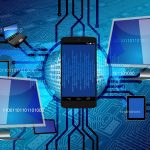Few people want to admit that no form of digital communication can ever be considered truly secure. Most netizens are likely to have an account for some useful service that could be leaking their data to the world. Whether due to a poor endpoint strategy on behalf of a vendor or a sketchy privacy policy that permits information to be released, there's always some risk. Take a … [Read more...] about What You Need to Know About Corporate Data Leak Vulnerabilities
Cybersecurity
Cybersecurity is the practice of protecting electronic information by mitigating information risks and vulnerabilities. Learn the basics of cybersecurity today.
What is SIEM and How Does it Relate to Big Data and Machine Learning?
Security Information and Event Management (SIEM) is a type of computer security software solution that combines real-time monitoring of IT infrastructure for security threats with the gathering and analysis of log data and event data collected from disparate components of the IT environment. The desired result of using SIEM is obtaining actionable information, such as … [Read more...] about What is SIEM and How Does it Relate to Big Data and Machine Learning?
Why Is Cybersecurity So Hard for Healthcare?
Look into the matter at all, and you'll see that the healthcare industry represents one of the most vulnerable sectors of the big data universe. That's why, not long ago, I discussed blockchain for electronic health records, which is a good idea because about 70 percent of healthcare firms have no cybersecurity insurance. In comparison, about 24 percent of all firms lack … [Read more...] about Why Is Cybersecurity So Hard for Healthcare?
Could Biometric Fingerprint Identification Replace Traditional Smart (Bank) Cards and Password Soon?
Unlike traditional smartcards most people are familiar with, a biometric payment card is a credit or debit card that uses the holder's fingerprint to verify the genuineness of one's transaction. Biometric cards introduce a layer of security that is not available in the traditional cards, the biometric fingerprint identification card possesses more impressive features. Various … [Read more...] about Could Biometric Fingerprint Identification Replace Traditional Smart (Bank) Cards and Password Soon?
Cybersecurity Misconceptions and Challenges Faced by Small Businesses
The digital and physical world share some eerie similarities. One of the main ones being the abundance of people who have bad dispositions. Evildoers continually hunt for exploitable targets. This isn't something only big businesses should be concerned with. Small to medium-sized businesses also need to be vigilant. There are many great reasons for this today. The Growing … [Read more...] about Cybersecurity Misconceptions and Challenges Faced by Small Businesses
What is cybersecurity?
Cybersecurity refers to protecting computer networks and systems from unauthorized access or attack. Cybersecurity analytics is the process of using data and analytics to identify, understand, and prevent cybersecurity threats. Want to learn more about cybersecurity? Datafloq has courses available. Contact us to get started.
What does cybersecurity do?
Cybersecurity analysts use data mining, machine learning, and other techniques to identify patterns that could indicate a cybersecurity threat. They then work to understand how the threat could be used to attack a system and finally work to prevent it from being realized. Cybersecurity is critical to any organization’s IT infrastructure, and businesses need to protect their data systems from cyber threats.
Why is cybersecurity important?
By investing in cybersecurity, businesses and individuals can safeguard their information from attacks by hackers and other malicious actors. In addition, cybersecurity can help to prevent identity theft, protect sensitive data, and ensure the confidentiality of online communications. As the world becomes more reliant on technology, cybersecurity will only become more important in the future.
How does cybersecurity work?
To put it simply, cybersecurity is all about identifying potential threats and then taking steps to neutralize them. This can be done through firewalls and encryption, making it more difficult for attackers to gain access to a system. And it also involves training users on how to spot a phishing email, so they don’t fall victim to an attack.
What are cybersecurity threats?
Cybersecurity threats can come in many forms, ranging from phishing attacks and viruses to malware and ransomware. While some threats are more serious than others, all can potentially lead to the loss of sensitive data or financial damages. Businesses and organizations of all sizes need to be aware of the latest cybersecurity threats and take steps to protect themselves.
How does cybersecurity affect business?
In today’s increasingly connected world, cybersecurity is more important than ever for businesses of all sizes. A security breach can lead to the loss of confidential data, customers, and revenue. In some cases, it can even result in legal liability.
As a result, businesses must protect themselves from cyber threats. This includes investing in security software and training employees on best practices for keeping data safe. Businesses can minimize the risk of suffering damaging cybersecurity incidents by taking these measures.
How does digital access impact various areas of cybersecurity?
Digital access has impacted various areas of cybersecurity in a few ways. One way is that organizations are now more aware of the importance of data security and have increased their focus on protecting their data. Additionally, digital access has allowed for the development of new technologies and organizations dedicated to improving cybersecurity.
Finally, digital access has made it easier for individuals to access cybersecurity information and learn about new threats. As a result, digital access has positively impacted cybersecurity by increasing awareness, developing new technologies, and making it easier to learn about cybersecurity threats.







